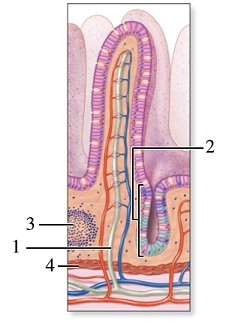In a lab setting, heating a vessel full of reactants will generally
A. lower the activation energy and the kinetic energy of the reactants.
B. lower the reaction rate due to the change in structure of the reactants.
C. convert products to reactants by increasing the energy requirements.
D. increase the kinetic energy of the molecules and increase the reaction rate.
E. raise the activation energy and catalyze the reaction.
Answer: D
You might also like to view...
 This figure shows an intestinal villus. What is the invagination indicated by number 2?
This figure shows an intestinal villus. What is the invagination indicated by number 2?
A. Endocrine gland B. Gastric gland C. Peyer patch D. Intestinal gland E. Lymphatic nodule
Which of the following is the correct description of the pia mater?
A. The layer of the meninges that is thin and weblike B. The outermost layer of the meninges C. The innermost layer of the meninges D. The layer of the meninges that is much thicker and tougher than the others E. The middle layer of the meninges
Which of the following types of connective tissue is avascular (contains no blood vessels)?
A. Reticular connective tissue B. Bone C. Cartilage D. Adipose tissue E. Areolar connective tissue
Which of the following is most distal in location on the humerus?
A. trochlea B. greater tubercle C. deltoid tuberosity D. medial epicondyle E. anatomical neck